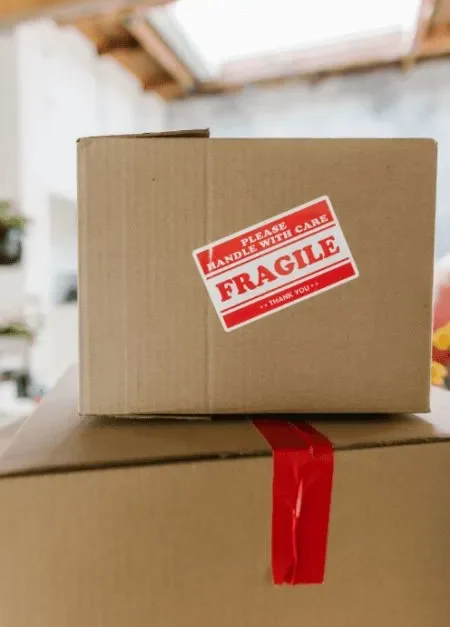
Packing fragile items can seem like an insurmountable task, whether you’re moving, shipping, or putting them away. Proper packing is the key to preventing breakage and ensuring that your possessions arrive at their destination safe and sound. This guide will give you step-by-step instructions on how to pack fragile things safely and efficiently.
What Are Fragile Things?
Fragile articles include glassware, ceramics, cutlery, antiquities, and other delicate objects. Because of their extreme vulnerability to damage, special care must be taken when packing these items. Understanding the nature of the item you are packing will help decide on both appropriate materials and techniques. At Experience Removal, we are here to guide you through the process. In the following, we will provide you with packing tips to ensure a safe transfer of your fragile items. See Packing Dishes and Glasses for Moving.
CALL US ANY TIME ON 020 3633 4324
Essential Packing Materials
Materials required for packaging can be explained as follows:
- Bubble Wrap: provides shock absorption and cushioning. This material helps protect fragile items from hits and shakes during transport.
- Packing paper: is an excellent material for wrapping items and filling boxes. Its open holes allow it to easily mold around objects, providing protection and cushioning.
- Cardboard Boxes: It’s important to use strong boxes that can hold the weight of your items. Strong boxes will ensure that your items are protected and won’t break or collapse during the moving process. Make sure the boxes are in good condition and made of high-quality materials to handle the load.
- Packing peanuts: are great for filling spaces in boxes. These lightweight materials are perfect for keeping items secure by preventing movement during transport. Simply pour the packing peanuts around your items to ensure they stay in place and are well-protected.
- Tape: Use strong packing tape to securely seal boxes. This type of tape ensures that your boxes stay closed and protected during transport. It’s essential for keeping your belongings safe.
- Markers: Use markers to correctly label boxes. Clear labelling helps you identify the contents of each box quickly and ensures that items are handled properly during the move. Marking boxes with their contents and destination room can make unpacking much easier.

Step by Step Fragile Items Packing Order
organise Your Packing Area
Makw sure you have got sufficient space to work in a calm setting where you won’t be disturbed. This will help you remain focused and make the packing process more proficient. Arrange all your pressing materials, such as boxes, tape, bubble wrap, and markers, inside easy reach. Having everything organised and at hand will make the process smoother and faster.
Wrap Each Item Individually
Every fragiles should be provided with a single wrap of bubble wrap or packing paper: the first becomes an inner pocket to provide for a shock-absorbance type of opportunity, so that when set down, the softer package absorbs the shock, direct contact not being made. The act of double wrapping with glass or ceramic items is very proficient, providing some extra cushioning. This is done to increase the amount of wrapping coverage for protective reasons so that less chance is given to the item going bad or breaking. When wrapping each piece of this box, tape one side of the entire length of this packing bubble wrap. This is to prevent the unfolding of the wrap while transporting the move. This ensures that the wrap remains tightly enclosed around the items for the entire transportation process.
Choose the Right Box Size
Select a box that’s somewhat greater than the thing you’re packing. This additional space allows for a few padding around the item. In any case, dodge overloading the boxes. Overstuffed boxes can become too heavy and risky. It’s important to put heavier things at the bottom to keep the box steady and less demanding to handle.
Pad the Base of the Box
Begin by putting a layer of packing peanuts or crumpled pressing paper at the bottom of the box. This beginning layer acts as a cushion, giving a defensive boundary for your fragile things. It helps to assimilate stuns and prevents direct impact from the bottom of the box, ensuring that your sensitive things stay safe during transport.
Insert Items into the Box
Carefully put each wrapped item into the box. Make sure to put the heavier things at the bottom and the lighter ones on top. On the off chance that there are any empty spaces, fill them with packing peanuts or folded paper. This helps to pad your things and prevent them from moving around during the move.
Seal the top of the package
Finally, after having packed all the items into the box, fold down the flaps properly and securely and seal it up with heavy packing tape. Then, reinforce all of the seams by taping. This will be sure it remains shut, but it also helps protect the contents within during the move.
Label Your Boxes
Clearly mark Fragile on each side of your boxes using a marker. This way, anyone handling the boxes will know to be careful with them. Proper labelling ensures that your delicate items receive the attention they need during the move.
Feel overwhelmed by Packing Fragile Items?
Give it to Experience Removal to take care of! Our expertise is to make sure that your fragile items are delivered without incident and safely. From carefully packing your belongings to unpacking them at your new house, our first-class moving services handle everything. Let us do the actual heavy lifting while you relax. With our committed staff at your side, have a stress-free and easy relocation.






